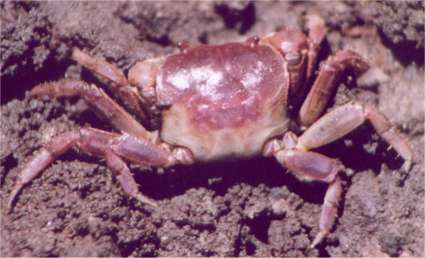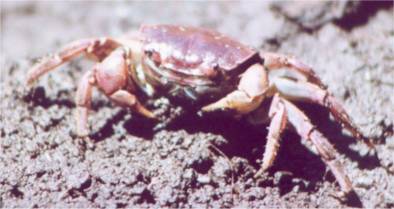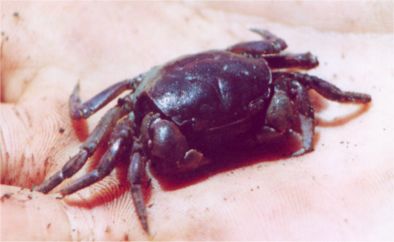|
A field guide to Kenyan
mangroves
|
Sarmatium crassum (Dana, 1851)
Family: Sesarmidae

Zone: Quiet forests of Rhizophora mucronata, mid-forest (Ruwa, 1997; Gillikin, 2000). Hartnoll (1975) collected specimens from the C. tagal zone.
Habitat: This species either burrows among, or is parasitic to, N. smithi burrows (Gillikin, 2000).
Food: probably similar to N. smithi.
Ecological notes: Prefers lower elevations and lower salinities; highly cryptic; only found by digging, never seen out of burrow (Gillikin, 2000). Small eyes probably because they are mostly living in dark burrows, a feature common to cave fauna. When they are set free on the open ground, they seem rather disoriented and do not run as most magrove crabs do.

Distinguishing characteristics: Crapace grey-blue. Front squared, inner orbital angles prominent, antero-lateral teeth rounded. When caught remains still in a 'ball' (carapace width about 2.5 cm). Small eyes.

Geographical range: Kenya, Tanzania, ???
References:
Cannicci, S., F. Dahdouh-Guebas and L. Montemagno, 1993. "Field Keys for Kenyan Mangrove Crabs." Museo Zoologico "La Specola", Dipartimento di Biologia Animale e Genetica dell'Università Degli Studi di Firenze, Via Romana 17, I-50125 Firenze, Italia.
Gillikin, D.P., 2000. Factors controlling the distribution of Kenyan brachyuran mangrove crabs: Salinity tolerance and ecophysiology of two Kenyan Neosarmatium species. M.Sc. Thesis, Free University of Brussels, Brussels, Belgium.
Hartnoll, R.G., 1975. "The Grapsidae and Ocypodidae (Decapoda: Brachyura) of Tanzania." J. Zool. Lond. 177:305-328.
Ruwa, R.K., 1997. "Zonation of burrowing crabs in the mangroves of the East Coast of Kenya." In Kjerfve, Björn, Luiz Drude de Lacerdaand El Hadji Salif Diop (eds.). Mangrove ecosystem studies in Latin America and Africa. UNESCO Technical Papers in Marine Science, Paris, France. Pp. 316-324.